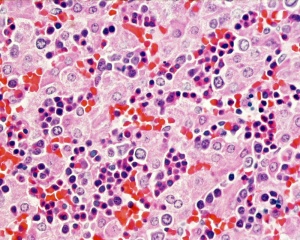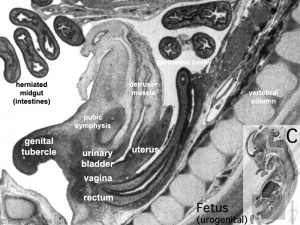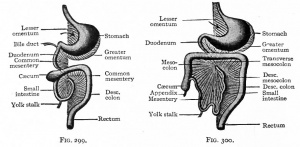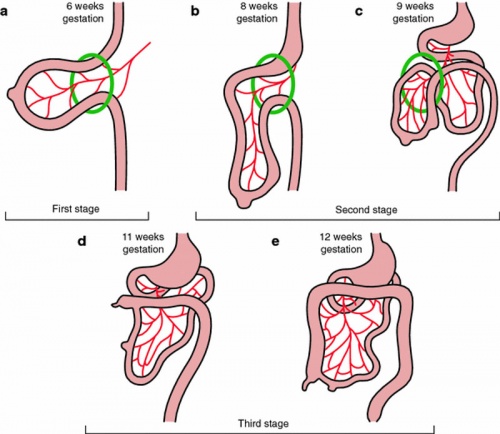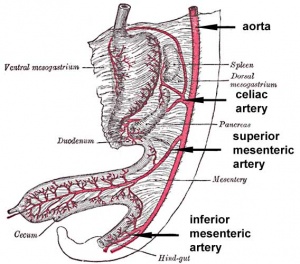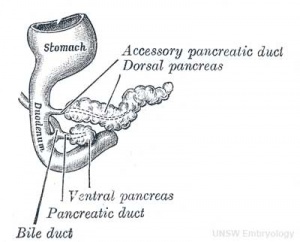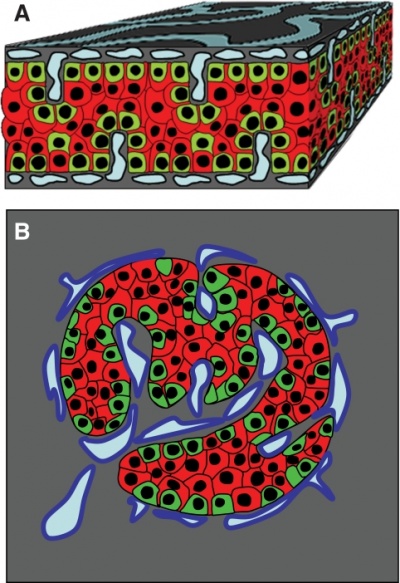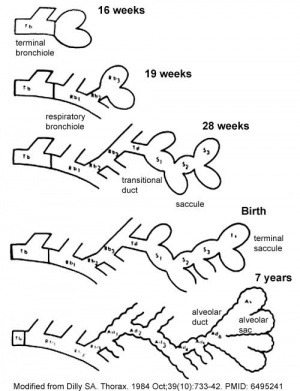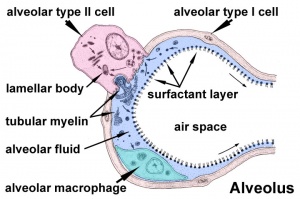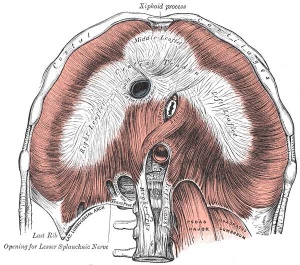ANAT2341 Lab 5 - Fetal
| Lab 5: Introduction | Trilaminar Embryo | Early Embryo | Late Embryo | Fetal | Postnatal | Abnormalities | Online Assessment |
Fetal Development
The Embryonic period involved transient structures to establish body and placental tissues, folding and form. The long human Fetal period (4x the embryonic period) is a time of extensive growth in size and mass as well as ongoing differentiation of organ systems established in the embryonic period. (More? See Fetal Notes)
As many students are new to embryology the majority of the practical class time has been spent introducing general concepts of early human development and combining this with the early formation of GIT structures. While the fetal period is substantially longer, there will be much less content to be covered.
Fetal developmental features include: the growth and rotation of intestines initially herniated outside the ventral body wall; changes in mesenteries; development of the blood supply and tract wall.
Finally consider the initial functions of the tract with amionic fluid swallowing and the accumulation of both secretions and swallowed components within the large intestine as meconium.
Early Fetus
Begin by just looking at the fetal anatomy in sections taken through the above 10 week female fetus (which is approximately 40 mm in size) and see how this compares with what you already know of adult GIT anatomy.
Related Images
Fetus (week 10) Planes A (most lateral), B (lateral), C (medial) and D (midline) from lateral towards the midline.
- Human Fetus - most lateral | lateral | medial | midline
- Head - most lateral | lateral | medial | midline
- Cerebellum - most lateral | lateral | medial | midline
- Urogenital Unlabelled - most lateral | lateral | medial | midline
- Urogenital Labelled - most lateral | lateral | medial | midline
- Large Images - midline
- Image Source: UNSW Embryology, no reproduction without permission.
There are 4 sections taken in the parasagittal and sagittal plane (moving from the right at Plane A towards the midline at Plane D). Click on the small images (or the text below) to open the linked large image pages.
Midgut Herniation
In the week 10 fetus (right) the midgut is still herniated (lying outside the ventral body wall) at the umbilicus. We saw in earlier pages that this heriation began back in the embryonic period (week 5) and the initial loop undergoes a series of rotations through embryonic and early fetal periods which position the midgut in its correct adult anatomical locations. These rotations are around the superior mesenteric artery (which supplies this region) and the associated mesentry. (Note this rotation is complicated and explained differently in different texts)
One week later (week 11) continued fetal body wall growth (and other factors) returns the midgut herniation returns to the abdominal cavity.
Small intestine growth in length is initially linear (first half pregnancy to 32 cm CRL), followed by rapid growth in the last 15 weeks doubling the overall length to term. Growth continues postnatally but after 1 year slows again to a linear increase to adulthood. (More? Intestine Development)
Simple cartoon of Rotation View from left hand side of embryo facing left. Sequence spans approx 6-11 weeks of development.
- There is an initial 90 degree rotation followed by 2 more 90 degree rotations to give 270 degrees total.
- The upper GIT is shader light green, the red vessel is the superior mesenteric artery (arising from the dorsal aorta).
Normal intestinal rotation (note these are GA gestational age weeks).[1]
Stomach Mesentery
Blood Supply
|
Each region of the gastrointestinal tract has a specific arterial supply which historically defined the 3 gastrointestinal tract regions (foregut, midgut and hindgut).
|
Fetal Tract Development
Week 11 - villi begin to appear in small intestine, goblet cells present
Week 16 - villi apparent in entire intestine
Adult small intestine will be divided into 3 regions with the same basic histological organization.
- duodenum (25-30 cm)
- jejunum (about first two-fifths of the rest)
- ileum
Week 20 - Peyer's patches appear in small intestine
The adult intestinal immune system includes:
- Peyer's patches
- isolated lymphoid follicles
- cryptopatches - small clusters of lymphoid cells with an immature lymphocyte phenotype and dendritic cells.
- mesenteric lymph nodes
Pancreas Development
- Pancreatic buds - duodenal level endoderm, splanchnic mesoderm forms dorsal and ventral mesentery, dorsal bud (larger, first), ventral bud (smaller, later)
- Pancreas Endoderm - pancreas may be opposite of liver
- Heart cells promote/notochord prevents liver formation
- Notochord may promote pancreas formation
- Heart may block pancreas formation
- Duodenum growth/rotation - brings ventral and dorsal buds together, fusion of buds
- Pancreatic duct - ventral bud duct and distal part of dorsal bud, exocrine function
- Islet cells - cords of endodermal cells form ducts, from which cells bud off to form islets
Pancreatic Islets
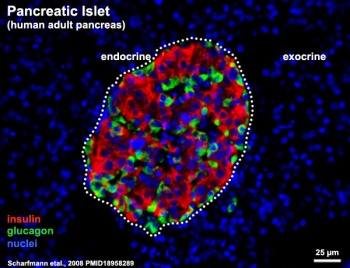
- Islets of Langerhans - 4 endocrine cell types
- Alpha - glucagon, mobilizes lipid
- Beta - insulin, increase glucose uptake
- Beta cells, stimulate fetal growth, continue to proliferate to postnatal, in infancy most abundant
- Delta - somatostatin, inhibits glucagon, insulin secretion
- F-cells - pancreatic polypeptide
Developing Pancreatic Islets
| Model of endocrine cell and vessel organization in human islets[3] | A α-Cells (green) and β-cells (red) are organized into a thick folded plate lined at both sides with vessels (blue).
B The plate with adjacent vessels is folded so that it forms an islet.
|
Pancreas Timeline
- Week 7 to 20 - pancreatic hormones secretion increases, small amount maternal insulin
- Week 10 - glucagon (alpha) differentiate first, somatostatin (delta), insulin (beta) cells differentiate, insulin secretion begins
- Week 15 - glucagon detectable in fetal plasma
Amniotic Fluid and Meconium
Amniotic Fluid Swallowing In early embryonic development both the buccopharyngeal and cloacal membranes degenerated, allowing the GIT to be filled with amniotic fluid. Towards the end of the fetal period the fetus is now swallowing approximately 500 ml of amniotic fluid / day.
This swallowed amniotic fluid moves through the GIT from esophagus, to stomach, to small intestine, stopping at the large bowel. In the large bowel the majority of fluid (water) is absorbed, along with electrolytes, glucose, urea and hormones. This process may contribute to fetal nutrition and prepare the GIT for its postnatal function. The process of swallowing amniotic fluid has been suggested to also help regulate fluid volume.
- Polyhydramnios (or hydramnios) refers to abnormally high amniotic fluid levels. This can be caused by a range of different abnormalities: byesophageal atresia, duodenal atresia, anencephaly, hydrops fetalis, achondroplasia, Beckwith-Wiedemann syndrome, diaphragmatic hernia, gastroschisis, multiple gestations (twins or triplets) or gestational diabetes.
Fetal Meconium (green fecal material) is the mixture of substances (debris, glandular secretions, fatty material and bile pigments) that accumulate in the large bowel. The mixture will form the neonatal meconium which is the first (usually within 24h to 48h) postnatal excretion from the GIT. If no discharge (bowel motion) is observed in this period it can be indicative of an abnormality of the GIT.
Meconium Aspiration can occur near term or at delivery, if meconiumis discharged into the amiotic fluid (meconium stained amniotic fluid) and then injested by the fetus as it swallows amiotic fluid. This can then lead to meconium aspiration syndrome (MAS), meconium drawn into the fetal/newborn lungs, causing inflammation, cell death and potentially perinatal death.
Respiratory Development
The sequence is most important rather than the actual timing, which is variable in the existing literature.
| Lung Stage | Human | Features | Vascular | |
|---|---|---|---|---|
| Embryonic | week 4 to 5 | lung buds originate as an outgrowth from the ventral wall of the foregut where lobar division occurs | extra pulmonary artery then lobular artery | |
| Pseudoglandular | week 5 to 17 | conducting epithelial tubes surrounded by thick mesenchyme are formed, extensive airway branching | Pre-acinar arteries | |
| Canalicular | week 16 to 25 | bronchioles are produced, increasing number of capillaries in close contact with cuboidal epithelium and the beginning of alveolar epithelium development | Intra-acinar arteries | |
| Saccular | week 24 to 40 | alveolar ducts and air sacs are developed | alveolar duct arteries | |
| Alveolar | late fetal to 8 years | secondary septation occurs, marked increase of the number and size of capillaries and alveoli | alveolar capillaries | |
| embryonic stage - pseudoglandular stage - canalicular stage - saccular stage - alveolar stage Links: Species Stage Comparison | respiratory | ||||
Canalicular stage
- week 16 - 24
- Lung morphology changes dramatically
- differentiation of the pulmonary epithelium results in the formation of the future air-blood tissue barrier.
- Surfactant synthesis and the canalization of the lung parenchyma by capillaries begin.
- future gas exchange regions can be distinguished from the future conducting airways of the lungs.
Saccular stage
- week 24 to near term.
- most peripheral airways form widened airspaces, termed saccules.
- saccules widen and lengthen the airspace (by the addition of new generations).
- future gas exchange region expands significantly.
- Fibroblastic cells also undergo differentiation, they produce extracellular matrix, collagen, and elastin. May have a role in epithelial differentiation and control of surfactant secretion
- The vascular tree also grows in length and diameter during this time.
- in late fetal development respiratory motions and amniotic fluid are thought to have a role in lung maturation.
- Development of this system is not completed until late fetal just before birth.
- Therefore premature babies have difficulties associated with insufficient surfactant (end month 6 alveolar cells type 2 appear and begin to secrete surfactant).
Diaphragm Development
Five elements contribute to the diaphragm.
|

|
- Links: DiaphragmDevelopment
- ↑ <pubmed>20549505</pubmed>| PMC2908440
- ↑ <pubmed>18958289</pubmed>| PLoS ONE
- ↑ <pubmed>20185817</pubmed>| PMC2857900 | Diabetes.
| Lab 5: Introduction | Trilaminar Embryo | Early Embryo | Late Embryo | Fetal | Postnatal | Abnormalities | Online Assessment |
Glossary Links
- Glossary: A | B | C | D | E | F | G | H | I | J | K | L | M | N | O | P | Q | R | S | T | U | V | W | X | Y | Z | Numbers | Symbols | Term Link
Cite this page: Hill, M.A. (2024, April 28) Embryology ANAT2341 Lab 5 - Fetal. Retrieved from https://embryology.med.unsw.edu.au/embryology/index.php/ANAT2341_Lab_5_-_Fetal
- © Dr Mark Hill 2024, UNSW Embryology ISBN: 978 0 7334 2609 4 - UNSW CRICOS Provider Code No. 00098G
